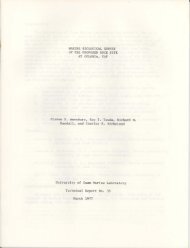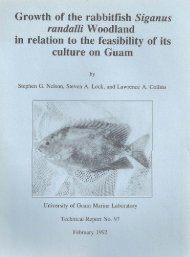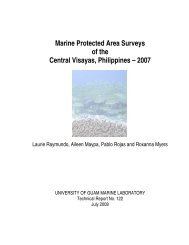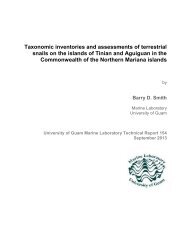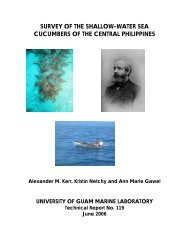UOGML Dive Manual - University of Guam Marine Laboratory
UOGML Dive Manual - University of Guam Marine Laboratory
UOGML Dive Manual - University of Guam Marine Laboratory
Create successful ePaper yourself
Turn your PDF publications into a flip-book with our unique Google optimized e-Paper software.
Prior to authorization to use nitrox, the following minimum requirements should be met:<br />
Training<br />
The diver must complete additional theoretical and practical training beyond the Scientific<br />
<strong>Dive</strong>r In Training air certification level, to the satisfaction <strong>of</strong> the DOG <strong>Marine</strong> <strong>Laboratory</strong><br />
DSO and DeB.<br />
Examinations<br />
Each diver should demonstrate pr<strong>of</strong>iciency in skills and theory in written, oral, and practical<br />
examinations covering:<br />
a) Written examinations covering the information presented in the classroom training<br />
session(s) (i.e., gas theory, oxygen toxicity, partial pressure determination, etc.);<br />
b) Practical examinations covering the information presented in the practical training<br />
session(s) (i.e., gas analysis, documentation procedures, etc.);<br />
c) Openwater checkout dives, to appropriate depths, to demonstrate the application <strong>of</strong><br />
theoretical and practical skills learned.<br />
Minimum Activity to Maintain Authorization<br />
The diver should log at least one nitrox dive per year. Failure to meet the minimum activity<br />
level may be cause for restriction or revocation <strong>of</strong> nitrox authorization.<br />
8.3 Nitrox Training Guidelines<br />
Training in these guidelines should be in addition to training for <strong>Dive</strong>r-In-Training authorization<br />
(Section 4.00). It may be included as part <strong>of</strong> training to satisfy the Scientific <strong>Dive</strong>r training<br />
requirements (Section 5.0).<br />
8.3.1 Classroom Instruction<br />
a) Topics should include, but are not limited to: review <strong>of</strong> previous training;<br />
physical gas laws pertaining to nitrox; partial pressure calculations and limits;<br />
equivalent air depth (EAD) concept and calculations; oxygen physiology and<br />
oxygen toxicity; calculation <strong>of</strong> oxygen exposure and maximum safe operating<br />
depth (MOD); determination <strong>of</strong> decompression schedules (both by EAD method<br />
using approved air dive tables, and using approved nitrox dive tables); dive<br />
planning and emergency procedures; mixing procedures and calculations; gas<br />
22





